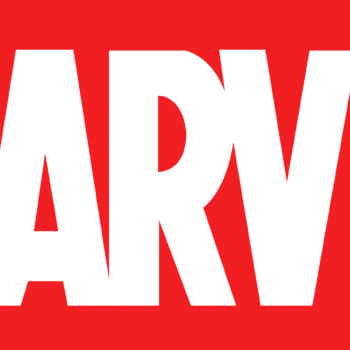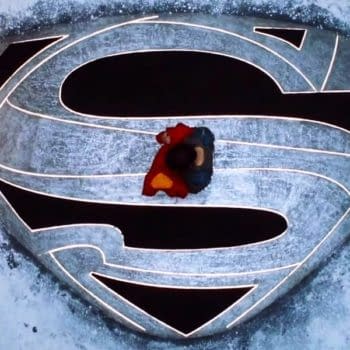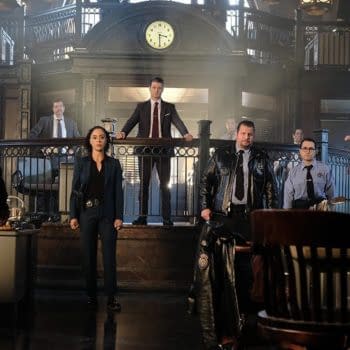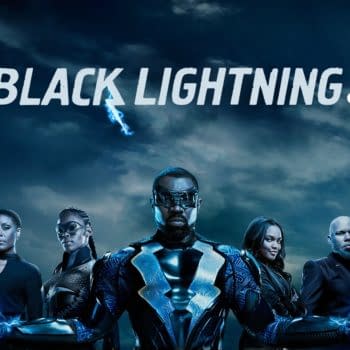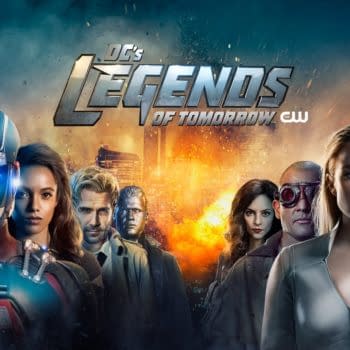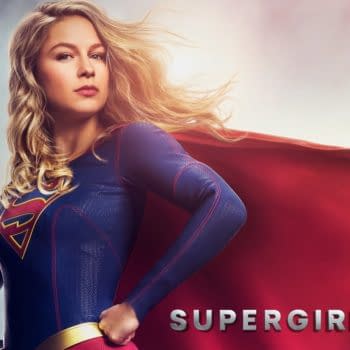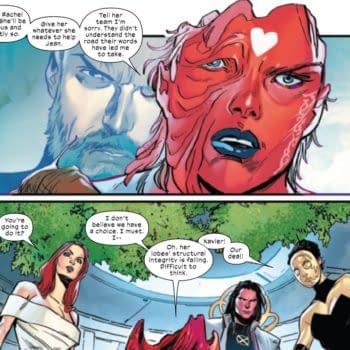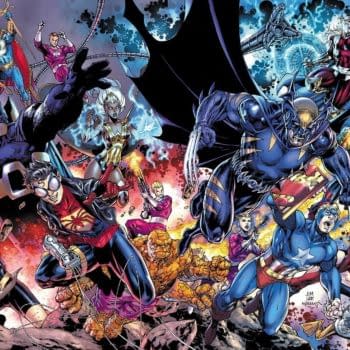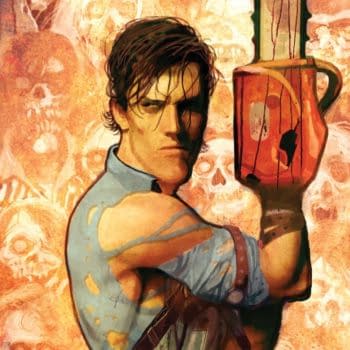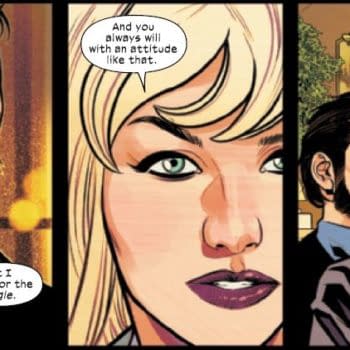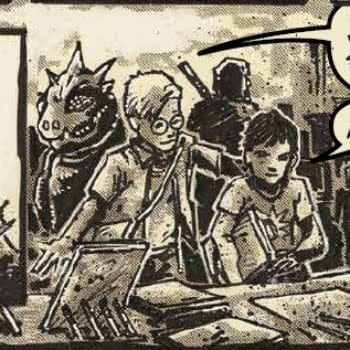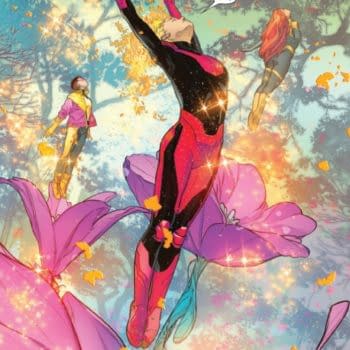Posted in: Comics | Tagged: alex cox, brian wood, Comics, dynamite, entertainment, Hayden Sherman, John Carter; The End
This Is The End… Alex Cox Talks About The New John Carter Series

DAN WICKLINE: This is called John Carter: The End, but how far out there are we talking? How long has it been since they left Mars and where does it fall on the timeline if his first trip to Barsoom was day one?
ALEX COX: It is far enough in the future that the Barsoom we know from Burroughs has changed radically… societies and landscapes have changed enough that there will be some culture shock. The actual year count is vague, but many generations have come and gone, and with Martian life cycles being longer than Earth, I think it's safe to say thousands of years have passed.
DW: In the series, they've gone off to mourn their child. But what child is this? He's referred to as "our great great grandson" and as "our son". Which is it? And just how many kids have they had over the years?
AC: John and Dejah have had many children beyond Carthoris and Tara, and Tara and Carthoris have had many children and grandchildren. So John and Dejah have raised, and help raise many children, but this child was the last of them all. This is a descendant that they have raised as their own, and was as close to them as any of their children, but he is the last, and they know it. All their hopes for legacy have been placed on him, and they see the weight of their long dynasty on his shoulders. So he is Heir, Grand-son, Son, Prince… the hope for the future of Mars, really.
DW: I understand doing things out of grief, but it seems strange for them to leave Mars all together. Were there other factors in their deciding to leave? And why go to a moon instead of back to Earth?
AC: This is a crippling grief, that takes them to a place that changes them dramatically. Once they lost their child, they lost all hope, so they sought out isolation… to "go off into the sunset", as it were. This moon was a hiding place, to leave the tragedies of Barsoom behind. When the story begins, they are really just living a life of total detachment and solitude, hiding from the past.
DW: How did you get involved with the project? Were you a John Carter fan prior to this opportunity? What was it about the series made you jump on board?
AC: I was (and am) a huge fan of John Carter. I'm sitting in front of a shelf of Barsoom books and collected comics, as I type this, with a set of the Sci-Fi Book Club hardcovers being a prized possession. So when Brian began to put ideas together for a John Carter project, knowing I was a huge fan of the series, he mentioned that he might need me as a resource or a sounding-board. I was more than happy to oblige. I knew he was going to bring a completely fresh take to the material, with a very solid emotional core to the story he wanted to tell, so when the opportunity came up to actually do some typing, I was ecstatic to get the opportunity, and really dig into what motivates these characters, especially in a new setting and circumstance.
DW: You are co-writing these scripts with Brian Wood. What is the collaboration process like? Do you two work out the plot then one scripts? Do you pass the script back and forth? How does it go from concept to ready-to-draw script?
AC: The idea for the story was all Brian, and from there, we shaped the details based on his outline. After that, it was kind of an amazing creative free-for-all, bouncing around ideas and story beats, and discussing the hows and whys. Having such a strong core concept meant that we could spin lots of cool twists around, as long as they stayed anchored to that one central idea.
Process-wise, there's not really any one method from issue to issue. We have very different styles and different interests, and Brian has a very strong voice as an author, which is important to stay true to. But it all works out, because ultimately we both want to tell a fun story with a real heart to it, and we clicked immediately on the tone and the feel of the thing. And of course, the editorial collaboration is important… Joe and Anthony do an amazing job keeping everything wrangled and on point, especially considering how unconventional this story is. It's all been a great experience, and I've learned an enormous amount working with Brian.
DW: How did you guys decide on Hayden Sherman for the art? What is it about his work that made him the right choice? What do you think he brings to the table that another artist might not.
AC: That was a decision by Dynamite., and I think they found him in THE AMAZING ARTIST SUPER-STORE. His work is absolutely outstanding. I was thinking recently that someday, when Hayden is a superstar, people will still be reading this story because fans will be tracking down his "early work". It's awesome that he's involved, and the editorial staff at Dynamite deserve an award for getting him on this.
Hayden's designs for this series draw on the graphic history of John Carter, going back to the earliest pulp-style illustrations, the Jesse Marsh comics from the 1950s, and a dozen other visual references super-fans will be excited to see. But he also brings a mix of stylistic influences that range (and I'm guessing here) from Otomo to Bilal to Miller to Chaykin to Krigstein. His storytelling chops are out of sight, and on every page you can see someone who really understands the visual power of comic art. This looks like no other JOHN CARTER comic ever before, but it still feels accurate. Anyone that has seen the Frazetta illustrations but can still redesign the world and make it their own… that's impressive. This is a guy who is going to be huge.
The colorist, Chris O'Halloran is doing a helluva job as well. Brian and I wanted to evoke that visually groundbreaking european sci-fi of the 1970s, and these guys absolutely nailed the feel of that material without aping the techniques. I'm over the moon looking at what they have done so far.
DW: Stepping back from the series and looking at it from a comic fan perspective, what is it about this series that gets you excited? What do you think will make readers talk about it?
AC: The art is spectacular. This is going to be a breakout book for Hayden. He has completely made Barsoom his own, which, as I mentioned before, is no easy task. Almost an impossible one. I have a stack of JOHN CARTER comic collections here and Hayden's art stacks up with anything in this pile, and honestly, blows a lot of it out of the water.
Beyond that, Brian and I have some surprises that start to appear in issue 2 and get weirder and wilder as it goes on. It's exactly the kind of story I want to be reading, and hopefully I'm not the only one! Fans of Brian will also be very pleased. It is definitely a book that hits the themes of his other works, and he has managed to keep the hallmarks of his style front and center. This is about real characters struggling with a difficult situation, and how they manage their humanity in dire conditions, despite this being set on a far-nurture Mars, The backbone of it is all Brian.
DW: Since this is called John Carter: The End, is this going to be considered how the Warlord of Mars ends his adventures or is this just a possible ending?
AC: I guess that's not for us to say? For me, on the final page, I hope we will wrap up everything that Edgar Rice Burroughs was trying to say with John Carter, and put a pin in his story. John Carter is a bigger concept than just a swashbuckler with a sword on a flying ship, and thousands of years from now, where we end his exploits should be pretty cool for fans, even if it's not canonical.
Let's call it canonical in spirit… how does that sound?








